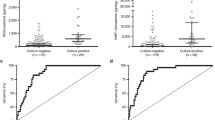Abstract
Aim of study was evaluation of urine levels of HD5 and HNP 1–3 at diagnosis of urinary tract infection (UTI) in children. Forty-two urine samples with positive urine culture were patient group whereas 46 urine samples with negative urine culture were control group. Demographic characteristics, automated urinalysis, laboratory results were recorded. All urine samples were evaluated microscopically by a single physician. Median values of HD5 levels in urine of patient and control groups were 187.8 pg/mg and 159.1 pg/mg respectively (p = 0.291). Median value of HNP 1–3 levels in urine of patient and control groups were 8875 pg/mg and 5465 pg/mg respectively (p = 0.145). Results of ROC analysis for HD5 levels and HNP1-3 levels demonstrated that they were not good enough for diagnosis of UTI (AUC = 0.571, p = 0.291 for HD5 and AUC = 0.590, p = 0.145 for HNP1-3 levels). Both positive result for leukocyte esterase and nitrite tests had highest sensitivity (95.2%) and specificity (97.8%) for diagnosis of UTI. The most frequent complaint was dysuria (28.66%) in the patient group. Manual urine examination was found to be more successful than automated urinalysis for predicting growth of microorganism in urine culture. Escherichia coli was most frequently isolated microorganism in urine. Both positive result for leukocyte esterase and nitrit test had highest sensitivity and specificity to define UTI. Bacteriuria in manuel urine microscopy had higher sensitivity and specificity than that of automated urinalysis. Urine HD5 and HNP1-3 levels were not good to define UTI in children.



Similar content being viewed by others
Abbreviations
- AMP:
-
Antimicrobial peptides
- CRP:
-
C reactive protein
- HD-5:
-
Human alpha defensin-5
- HNP1-3:
-
Human neutrophil peptide 1–3
- UTI:
-
Urinary tract ınfection
References
Ali AS, Townes CL, Hall J, Pickard RS (2009) Maintaining a sterile urinary tract: the role of antimicrobial peptides. J Urol 182(1):21–28
Bachur R, Harper MB (2001) Reliability of the urinalysis for predicting urinary tract infections in young febrile children. Arch Pediatric Adolesc Med 155(1):60–65
Becknell B, Schober M, Korbel L, Spencer JD (2015) The diagnosis, evaluation and treatment of acute and recurrent pediatric urinary tract infections. Expert Rev Anti-infec Ther 13(1):81–90
Ihi T, Nakazato M, Mukae H, Matsukura S (1997) Elevated concentrations of human neutrophil peptides in plasma, blood, and body fluids from patients with infections. Clin Infect Dis 25(5):1134–1140
Landis JR, Koch GG (1977) The measurement of observer agreement for categorical data. Biometrics 33:159–174
Mayo S, Acevedo D, Quiñones-Torrelo C, Canós I, Sancho M (2008) Clinical laboratory automated urinalysis: comparison among automated microscopy, flow cytometry, two test strips analyzers, and manual microscopic examination of the urine sediments. J Clin Lab Anal 22(4):262–270
Memişoğulları R, Yüksel H, Yıldırım HA, Yavuz Ö (2010) Performance characteristics of dipstick and microscopic urinalysis for diagnosis of urinary tract infection. Eur J Gen Med 7(2):174–178
Ohlsson S, Ljungkrantz I, Ohlsson K, Segelmark M, Wieslander J (2001) Novel distribution of the secretory leucocyte proteinase inhibitor in kidney. Med İnflamm 10(6):347–350
Ray P, Le Manach Y, Riou B, Houle TT (2010) Statistical evaluation of a biomarker. Anesthesiology 112(4):1023–1040
Roberts KB (2011) Urinary tract infection: clinical practice guideline for the diagnosis and management of the initial UTI in febrile infants and children 2 to 24 months. Pediatrics 128(3):595–610
Spencer JD, Hains DS, Porter E, Bevins CL, DiRosario J, Becknell B et al (2012) Human alpha defensin 5 expression in the human kidney and urinary tract. PLoS ONE 7(2):e31712
Spencer JD, Schwaderer AL, Becknell B, Watson J, Hains DS (2014) The innate immune response during urinary tract infection and pyelonephritis. Pediatr Nephrol 29(7):1139–1149
Tikhonov I, Rebenok A, Chyzh A (1997) A study of interleukin-8 and defensins in urine and plasma of patients with pyelonephritis and glomerulonephritis. Nephrol Dial Transplant 12:2557–2561
Watson JR, Hains DS, Cohen DM, Spencer JD, Kline JM, Yin H et al (2016) Evaluation of novel urinary tract infection biomarkers in children. Pediatr Res 79(6):934–939
Zasloff M (2002) Antimicrobial peptides of multicellular organisms. Nature 415(6870):389
Funding
There is no funding source.
Author information
Authors and Affiliations
Contributions
SK and AUG designed the study. SK collected urine samples and done urine microskoby. OOG and PK studied antimicrobial peptides in urine. SK and AUG evaluated results. AUG draft the manuscript. All authors read and approved the final manuscript.
Corresponding author
Ethics declarations
Conflict of interest
The authors declare that they have no conflict of interest.
Ethical Approval
This study was performed in line with the principles of the Declaration of Helsinki. The study protocol was approved by the Ethics Review Board of University Of Health Sciences Ankara Child Health and Hematology-Oncology Education and Research Hospital (Number: 2018-56).
Informed Consent
Informed consent was obtained from parents.
Additional information
Publisher's Note
Springer Nature remains neutral with regard to jurisdictional claims in published maps and institutional affiliations.
Rights and permissions
About this article
Cite this article
Kara, S., Gökceoğlu, A.U., Demirel, Ö.Ö. et al. Evaluation of Antimicrobial Peptides at the Diagnosis of Urinary Tract Infection in Children. Int J Pept Res Ther 27, 275–280 (2021). https://doi.org/10.1007/s10989-020-10083-x
Accepted:
Published:
Issue Date:
DOI: https://doi.org/10.1007/s10989-020-10083-x




